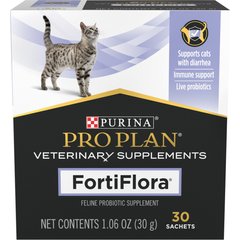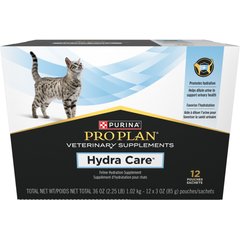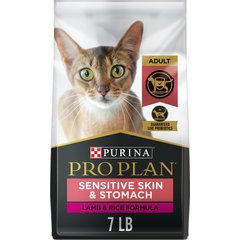How to Read a Cat Food Label
PetMD Editorial
Choosing the Best Cat Food
By Vanessa Voltolina
Whether you’ve just brought a new kitten into your home, or your fussy feline demands a re-evaluation of the dinnertime goods, it’s important to be knowledgeable on deciphering pet foods labels. Does grain-free mean lower in carbs? What’s a Guaranteed Analysis?
Questions abound when it comes to pet food label analysis. Expert Ashley Hughes, Doctor of Veterinary Medicine at American Animal Hospital Association-accredited Friendship Hospital for Animals in Washington, DC, weighed in on what consumers should look for on cat food labels to keep pets feeling healthy and satisfied at every meal.
#1 Scan the First 3 Ingredients
To ensure that your cat gets enough good sources of protein – think chicken, beef, fish and lamb -- check the first three ingredients on the label. Pet food labels list ingredients in order of the weight of the ingredient, starting with the heaviest.
If chicken meal tops the list, it usually means more protein, says Hughes. Regular chicken is 80% water, which can move up the ingredients list even based on water weight — water that is then removed to make dry cat food. Products like chicken meal (and other protein meals) are dehydrated, meaning that if it’s at the top, it will provide an appropriate level of protein.
How to Read a Cat Food Label
 Feliway Optimum Enhanced Calming 30 Day Diffuser for CatsRated 3.9 out of 5 stars1545Reviews$29.99Chewy Price
Feliway Optimum Enhanced Calming 30 Day Diffuser for CatsRated 3.9 out of 5 stars1545Reviews$29.99Chewy Price Purina Pro Plan Veterinary Diets FortiFlora Powder Probiotic Digestive Supplement for Cats, 30 countRated 4.7 out of 5 stars5505Reviews$30.99Chewy Price
Purina Pro Plan Veterinary Diets FortiFlora Powder Probiotic Digestive Supplement for Cats, 30 countRated 4.7 out of 5 stars5505Reviews$30.99Chewy Price Purina Pro Plan Veterinary Diets Hydra Care Liver Flavored Liquid Supplement for Cats, 3-oz pouch, case of 12Rated 4.4 out of 5 stars2534Reviews$14.99Chewy Price
Purina Pro Plan Veterinary Diets Hydra Care Liver Flavored Liquid Supplement for Cats, 3-oz pouch, case of 12Rated 4.4 out of 5 stars2534Reviews$14.99Chewy Price Purina Pro Plan Adult Sensitive Skin & Stomach Lamb & Rice Formula Dry Cat Food, 7-lb bagRated 4.6 out of 5 stars2193Reviews$28.08Chewy Price
Purina Pro Plan Adult Sensitive Skin & Stomach Lamb & Rice Formula Dry Cat Food, 7-lb bagRated 4.6 out of 5 stars2193Reviews$28.08Chewy Price
#3 Grain-Free Isn’t Carb-Free
Many owners worry about cats carrying excess pounds and opt for grain-free foods. While purchasing foods lower in carbohydrates and higher in protein is helpful, take a closer look at the label. Even if food is “grain-free,” it can still be loaded with carbs like potatoes and veggies. Hughes says your cat may still keep consuming the same, if not more, carbohydrates. Remember that properly processed carbs can be utilized by cats as an excellent energy source and are not necessarily bad.
#4 Check the Guaranteed Analysis
Check your pet food label for the mandatory guarantee that the food contains the nutrition levels, or labeled percentages of crude protein, fat, fiber, and moisture. While “crude” may seem like a distasteful term, on these labels it refers to the method of testing the product, not the quality of the nutrient itself. Also, although the guaranteed analysis provides a measure of the various nutrient categories, it does not provide any information relating to the quality of the ingredients in the food, its digestibility or the overall quality of the food.
#5 Correctly Compare Canned & Dry Food
After you’ve checked the Guaranteed Analysis, cat owners should note that wet and dry foods use different standards. For instance, 8% protein in a canned cat food isn’t the same as 8% in dry food (wet will be a lower percentage), since canned food contains 75-78% moisture and dry only has 10-12% water.
It’s best to convert canned food to dry matter and compare protein amounts. Easy conversions are available online, or ask your vet for help. Here is an example:
Divide the reported amount of protein (in this case, 8%) by the total amount of dry matter (25%). Then, multiply the result by 100. Dry Matter Protein = (8/25) x 100 = 32%
#6 Go Au Natural
Feeding your cat food labeled “natural” means that none of the ingredients have been chemical altered, according to FDA guidelines. Hooray! But what about food labeled only “holistic?” Leave it at the store, says Hughes. Since there is no legal definition for this term, it likely won’t have much impact on your cat’s diet.
For organic options, check the package for an official USDA label. If the seal says "organic" it must contain at least 95% organic ingredients, not counting added water or salt. If it says "Made With Organic Ingredients" it must contain at least 70% organic ingredients, not counting added water or salt.
If a manufacturer wants to show that a product has some organic ingredients, but they make up less than 70% of the total, it can denote those ingredients as “organic” in the ingredient list, but no seal is used.
#7 Figure Out Flavor Ingredients
While flavorings can help give your pet more of what they love (hello, tuna!), look for proteins in the first three ingredients to give your cat the flavor it wants. If you opt for a food with a certain flavor, choose specifics over generics, such as “beef” instead of “meat.” This provides a better idea of where the protein originated.
#8 Determine Kitty’s Nutrient Profile
Cat foods are generally marked with one of two AAFCO labels, “All Life Stages” or “Adult Maintenance.” All Life Stages cat food is formulated to meet requirements for a growing kitten (or lactating cat), meaning that the food will likely be higher in calories, calcium and phosphorus. Choose foods with the “Adult Maintenance” label for healthy cats, says Hughes.
#9 Find the Nutritional Adequacy Statement
Check the label to ensure that the manufacturer has formulated its pet food to meet minimum nutritional requirements (aka it’s a “formulated food”). Do this by looking for a statement on the packaging, which will read: “[Name] is formulated to meet the nutritional levels established by the AAFCO Cat Food Nutrient Profiles for [life stage(s)]"
#10 Strive for Feeding-Trial Food
Even better, look for a food that meets the minimum nutritional requirements “as fed” to real pets in an AAFCO (Association of American Feed Control Officials) defined feeding trial. Then you know the food truly delivers the nutrients that it is “formulated” to provide. AAFCO feeding trials are considered the gold standard. While not all pet food companies conduct these costly tests, those that do (Hill’s pet food and Nestle's pet food, among others) will tout labels that say so.